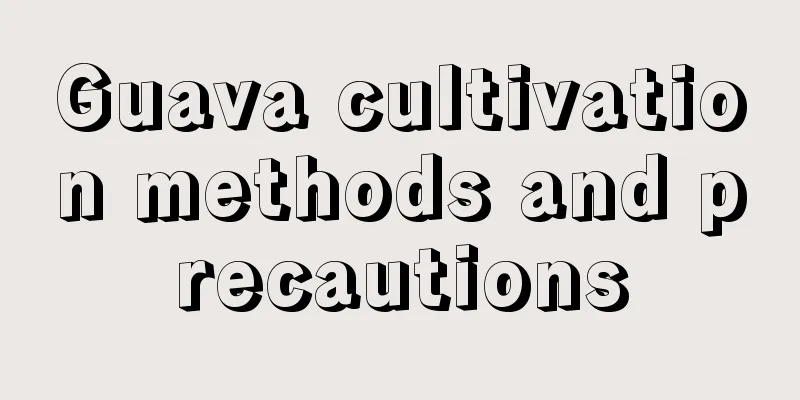Guava cultivation methods and precautions

1. Maintenance methods1. Temperature: If the temperature is below zero degrees, the plants will be frozen to death. Therefore, the maintenance temperature should be higher. The lowest maintenance temperature is 15 degrees. It will only grow when the temperature reaches 15 degrees. The best maintenance temperature is between 20 and 28 degrees. The plant grows best at this temperature. 2. Watering: If it is not a dry season, there is no need to water it. If the drought lasts for more than two months, it needs to be artificially irrigated, otherwise it will affect the yield. When watering, observe the state of the soil first. Watering is only needed when the soil is completely dry. Normally, it needs to be watered once a week. 3. Fertilization: Fertilize it according to the method of applying thin fertilizers frequently. It is not suitable to apply concentrated fertilizers, as concentrated fertilizers can easily burn the roots. You can use compound fertilizers or human feces and urine for fertilization, and the frequency of fertilization can be maintained at once a month. 4. Light: Its growth cannot be separated from light. Adequate light is of great benefit to its growth, which can promote growth and increase yield. If full-day sunlight is not possible, the daily light must be guaranteed to be at least five hours. 2. Breeding techniques1. Reproduction: It can be propagated by grafting. The breeding time is in winter and spring. When the seedlings grow to a diameter of 0.7 cm, they can be grafted. In the first half month of collecting the scion, pick the leaves and cut them off when the buds are about to sprout. The effect is best at this time. The thicker the rootstock is, the more nutrients it has accumulated, which is conducive to success. Generally, the binding is untied one month after the bud grafting. After the grafted bud heals and survives, the rootstock is cut off, and it can be transplanted and planted one year later. 2. Pruning: Pruning is required after the fruit is harvested. First, cut off the branches that grow too lushly; second, cut off the branches that are more than two centimeters long; finally, cut the general branches shorter. 3. Problem Diagnosis1. Pests: Aphids are its number one natural enemy. If found, they need to be treated with cypermethrin. 2. Diseases: The plants are more susceptible to canker and damping-off. If found, Bordeaux slurry can be used for spraying treatment. IV. Other issues1. Edibility: It is edible. 2. Other values: In addition to being edible, it can also be used as medicine and has the function of stopping bleeding. |
<<: Artemisia cultivation methods and precautions
>>: The cultivation methods and precautions of Smilax china
Recommend
What are the varieties of Vanda orchids?
There are many varieties of Vanda orchids, the mo...
What are the cultivation methods and precautions of Schefflera chinensis
Cultivation method of Schefflera chinensis Scheff...
Can succulents be planted in sand?
Can succulents be planted in sand? Succulents can...
If you water like this, it would be strange if the flowers died.
How to judge whether it is time to water? look Ch...
How to grow water bamboo in winter
1. Control the temperature When growing in winter...
How to grow spider plants so that they can grow vines
1. Reasonable lighting If you want the spider pla...
How to care for and water Nandina domestica?
Nandina domestica is an evergreen shrub that is l...
Corn growing environment and growing conditions
Corn growing environment and conditions Corn pref...
How to grow aloe vera more vigorously
1. The pot soil should be properly configured Pot...
Things to note for beginners when raising bonsai
Plant selection In general, the plants that can b...
Can hydrangeas be placed in the bedroom?
1. Is it possible? Hydrangea cannot be placed in ...
How to propagate elm and what to pay attention to
Elm tree reproduction method There are only two w...
What to do if the banyan bonsai leaves turn yellow and fall off
1. Watering correctly When caring for banyan bons...
Is smooth sailing poisonous?
1. Reasons The scientific name of the smooth sail...
Fig planting and cultivation techniques
The fig tree is a flowering plant belonging to th...









